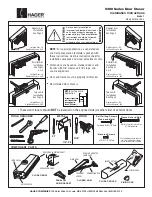
If the wire electrode is to be retracted further, the wire retract button
must be pressed again.
(4)
Wire threading button
For threading the wire electrode into the torch hosepack with no accom-
panying flow of gas or current
While the button is pressed, the wirefeeder runs at the preset feeder inch-
ing speed.
Wire threading can be performed using one of two methods:
Method 1
Retracting the wire electrode using the preset feeder inching speed:
Press and hold "Wire threading" button
-
The wire electrode will be threaded 1 mm (0.039 in.) after the wire
threading button is pressed
-
After a short pause, the wirefeeder continues to thread the wire elec-
trode. If the wire threading button remains pressed, the speed will in-
crease every second at a rate of 10 m/min (393.70 ipm) until the pre-
set feeder inching speed is reached
-
If the wire electrode comes into contact with a ground earth connec-
tion, the wirefeeding will be stopped and the wire electrode will be re-
tracted again by 1 mm (0.039 in.)
Method 2
Threading the wire electrode in 1 mm increments (0.039 in. increments) –
always press the wire threading button for less than one second (tap)
If the wire electrode comes into contact with a ground earth connection,
the wirefeeding will be stopped and the wire electrode will be retracted
again by 1 mm (0.039 in.).
IMPORTANT!
If there was a ground earth connection with the contact tip
before the wire threading button was pressed, the wire electrode will be
retracted when the button is pressed until it is short-circuit-free – it re-
tracts by no more than 10 mm (0.39 in.) with each press of the button.
If there is still a ground earth connection with the contact tip after 10 mm
(0.39 in.) after 10 mm (0.39 in.) of wire retraction, pressing the wire
threading button again will cause the wire electrode to be retracted again
by a maximum of 10 mm (0.39 in.). The process will be repeated until
there is no longer a ground earth connection with the contact tip.
(5)
Display
Status indicator
The statuses shown in the status indicator are described below
78
Summary of Contents for Pull
Page 2: ......
Page 21: ...System configurations 21...
Page 22: ...22...
Page 41: ...System components 41...
Page 42: ...42...
Page 56: ...OPT CAM Prepared for the camera recording option 56...
Page 67: ...Controls connections and mechan ical components 67...
Page 68: ...68...
Page 85: ...Assembling system components conventional robot 85...
Page 86: ...86...
Page 91: ...3 3 Nm 2 43 lb ft 2 6 Nm 4 43 lb ft 3 91 EN...
Page 95: ...Optimum hosep ack arrangement R R R 200 mm R 200 mm 95 EN...
Page 102: ...102...
Page 103: ...Assembling system components PAP robot 103...
Page 104: ...104...
Page 107: ...Fitting the SplitBox SB 500i R PAP Fitting the SB 500i R PAP 1 2 107 EN...
Page 110: ...4 Nm 2 95 lb ft 2 8 Nm 5 90 lb ft 3 110...
Page 112: ...11 Nm 8 11 lb ft 5 Fitting the WF Robacta Drive to the robot PAP 1 1 2 112...
Page 113: ...3 42 0411 1315 BY2 0201 4896 4 18 Nm 13 28 lb ft 5 113 EN...
Page 114: ...6 114...
Page 117: ...3 4 117 EN...
Page 118: ...118...
Page 119: ...Assembling further system com ponents 119...
Page 120: ...120...
Page 128: ...2 128...
Page 131: ...Steel inner liner 1 2 3 131 EN...
Page 134: ...Fitting the OPT i camera mount 1 2 3 4 134...
Page 137: ...5 6 Fitting the inner liner unreeling wirefeeder wire buffer 1 2 137 EN...
Page 138: ...3 4 5 Fitting the inner liner SplitBox WF 25i with in ternal inner liner 1 138...
Page 143: ...Start up 143...
Page 144: ...144...
Page 148: ...5 6 7 8 Torx 40 1 Nm 0 74 lb ft 9 10 148...
Page 150: ...5 12 mm 42 0411 0160 6 7 8 12 mm 5 Nm 3 69 lb ft 42 0411 0160 2 9 10 150...
Page 151: ...2 1 11 12 151 EN...
Page 156: ...156...
Page 157: ...Troubleshooting maintenance and disposal 157...
Page 158: ...158...
Page 168: ...3 4 Inserting the inner liner 1 2 3 4 168...
Page 173: ...Removing the CrashBox PAP from the robot 1 BY2 0201 4896 2 3 4 5 1 6 173 EN...
Page 175: ...Technical data 175...
Page 176: ...176...
Page 181: ...Triggering torques and weight distance diagram 181 EN...
Page 188: ...The product conforms to the requirements of the IEC 60974 7 standard ED Duty cycle 188...
Page 195: ...195 EN...
















































